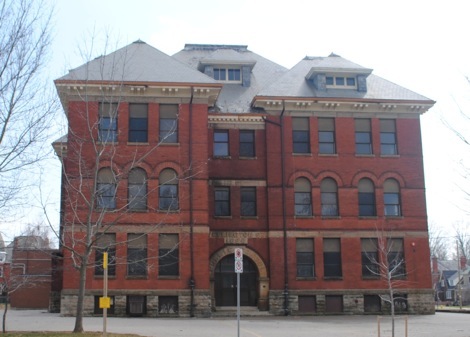
Algoma University’s two-year-old extension campus in St. Thomas, Ontario has failed to achieve financial viability and intake of new students was quietly suspended this fall.
University officials are hoping to re-launch academic programming there in the fall of 2015.
The original idea was to boost the university’s overall enrolment and increase interest in under-prescribed programs by offering the first two years of a bachelor of arts degree in St. Thomas, expecting that students would complete their degree here in Sault Ste. Marie.
With support from a private donor and the City of Sault Ste. Marie, space was renovated in the former Wellington Street Public School and classes started in the fall of 2012 with 18 full-time-equivalent students, short of the 20 to 25 needed to be financially viable.
In 2013, another 18 students started classes in St. Thomas.
“Although intake of new students was deferred for the fall of 2014, nine students are currently completing their second-year studies in St. Thomas and eight students are currently studying on our main campus, who made their initial connection with AU through this extension site,” said Brian Leahy, director of extension programming, in a recent report to the Algoma University senate.
“Given our experiences to date, it was clear that strategies needed to be developed to overcome the challenges we have faced,” Leahy said.
The St. Thomas extension has used the controversial block plan proposed by departing president Dr. Richard Myers.
Under that delivery platform, St. Thomas students take just one course at a time, completing a three-credit course in three weeks.
In April, 2012, Dr. Myers was clearly excited about the block plan’s potential.
"I think the response to our offerings in St. Thomas shows how appealing this distinctive approach could be," he said in a news release. "We envisioned the St. Thomas programming as a service to students from that community. To our great surprise, we've had applications from students in Ottawa, Toronto, Kitchener and other communities who want to move to St. Thomas in order to experience block-style education."
Myers had also tried to get the block plan adopted at Algoma University’s Sault campus, but the university’s senate rejected the idea on March 30, 2012.
A re-launch plan to be presented to the university senate proposes continuing with five block-plan courses but also adding one or two traditional 15-week courses in the evening.
Other proposed changes include adding online and video conferencing options, and a one-year program for students wanting to finish first-year university level studies.
The initial offering of five courses per semester would be increased to six or seven courses per semester, possibly including introductory courses in forensics, and law and justice.
“This extension faced numerous challenges during its first two years of operation; however, similar to the start-up of any business, the key to long-term success is the ability to adapt to such challenges,” Leahy said in his report to senate.
“In the simplest of terms, in order to succeed, Algoma University must revise its current programming to better target the needs of the community and a concerted effort must be made to improve program promotion.”
“In order to increase the likelihood of success, we would immediately commence outreach activities within St. Thomas and the surrounding region. The Thames Valley School Board has expressed their strong willingness to directly assist with our efforts as they believe we can make this work. Every student, parent, teacher and guidance counsellor needs to know we are committed to ensuring our re-launch efforts are successful.”
Other suggestions from Algoma University’s faculty and other stakeholders include certificate, transition and English as a Second Language programming.
The proposed re-launch enrolment target for fall of 2015 is 15 to 20 full-time-equivalent students.
That’s not enough to cover expenses but private-donor support would be sought to carry the program through the initial two years of the re-launch.